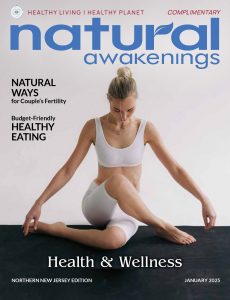Dangers in the Cosmetic Bag
Choose Safe and Healthy Natural Beauty Aids
We all want to look and feel beautiful, often enhancing our best features with assistance from cosmetics. Yet many of us may not be aware of the toxic ingredients contained in products we’re using.
“When the Federal Food, Drug, and Cosmetic Act was passed 77 years ago, it contained 112 pages of standards for food and drugs, and only one page for cosmetics,” says Connie Engel, Ph.D., science and education manager at the Breast Cancer Fund and its Campaign for Safe Cosmetics, in San Francisco.
While most cosmetic ingredients must be listed on product labels, sometimes their names are hard to recognize, many are toxic and some of the most dangerous ones may not even be listed. Labeled toxins commonly found in cosmetics include endocrine disruptors that can affect our developmental, reproductive, neurological and immune systems. Here are just a few:
Polytetrafluoroethylene (PTFE), also known as Teflon, is found in foundation, pressed powder, loose powder, bronzer, blush, eye shadow and mascara. It can even enhance the toxicity of other chemicals, according to Danish research published in the International Journal of Andrology, and due to its fluorine base, can disrupt iodine absorption, contributing to breast disease including cancer.
Butylated hydroxyanisole (BHA) and its cousin, hydroxytoluene (BHT), are common preservatives found in lip products, liquid makeup and moisturizers that the European Commission on Endocrine Disruption cites as interfering with hormone function. They’ve also been shown to cause kidney damage, according to research from Spain’s Universidad Autónoma de Madrid.
Formaldehyde in many forms, including quaternium-15, coal tar, benzene and mineral oils that are prohibited in the European Union and Japan, are classified as carcinogens by the International Agency for Research on Cancer.
These examples represent the tip of the iceberg of toxic chemicals of concern commonly used in cosmetics. They further range from allergens and substances that cause non-cancerous and cancerous tumors and organ toxicity to developmental and reproductive impairment, miscarriage and bioaccumulation leading to toxic overload when not excreted.
Fragrances don’t have to be included in label ingredient lists, constituting another major concern, explains Engel. “Most cosmetics, even eye shadow, contain fragrance, and those fragrances can contain several dozen unlabeled ingredients, including hormone-disrupting phthalates.”
The European Union is the authoritative source on all of these issues. Based on its CosIng (cosmetic ingredients) database accessed via ec.europa.eu/consumers/cosmetics/cosing, it has banned scores of toxic chemicals from makeup sold in EU countries.
Safe and Healthy Alternatives
Fortunately, safe alternatives are available to enhance our natural beauty. “Become an educated consumer and read the list of ingredients,” advises Janice Cox, the Medford, Oregon, author of Natural Beauty at Home. “Fewer ingredients and organic components mean safer products.”
Better yet, we can make our own more natural beauty aids. “One advantage of making your own is that you’re in control. You know yourself and your skin and sensitivities,” says Cox. DIY products are easy if intense color isn’t a requirement. “The color many people want is hard to produce with kitchen ingredients,” Cox explains. “You can make clear mascara and eyebrow tamer with castor oil. It’s easy to make lip balms and maybe get a little color by adding berry juice or beet root powder.”
For those that want the look of high-quality makeup without toxins, other good alternatives come into play, says Hollywood makeup artist Lina Hanson, author of Eco-Beautiful. “I had been working in the industry for several years before I discovered the toxic ingredients in makeup; I was shocked,” she says. Equally unsettling, “I also learned that many of the ingredients allowed in the U.S. are banned in the European Union because of their toxicity.”
That knowledge launched Hanson’s quest to create safe, organic, beauty-enhancing products for women, celebrities and everyday people alike. “So many people these days pay close attention to what they put in their bodies, but not everyone is as careful about what they put on their bodies,” she says. “I want people to understand that you don’t have to sacrifice beauty in going green.”
Hanson warns against so-called “natural” cosmetics that abuse the term and may include harmful preservatives and synthetic ingredients. She assures, “Any product labeled ‘USDA certified organic’ contains 100 percent organic ingredients.” Her book mentions numerous brands she recommends.
Beauty Bonus Tip
Healthy, moisturized skin is essential to natural beauty, many experts agree, noting that younger women need to unclog pores to prevent acne. They don’t need much moisturizing, but skin generally becomes drier with age, making good moisturizers important. Cox recommends jojoba oil to effect glowing skin. Hanson likes coconut oil, although she recommends rubbing it in, removing makeup and then taking it off with a hot, wet towel.
The Campaign for Safe Cosmetics (SafeCosmetics.org) has created a helpful app for iPhone and Android users at ThinkDirtyApp.com. Simply download it and scan a store item’s barcode to immediately access information on the product’s toxic ingredients, along with recommendations for healthier alternatives.
Kathleen Barnes is the author of many natural health books, including Food Is Medicine. Connect at KathleenBarnes.com.
DIY Island Lip Gloss
1 tsp grated beeswax
1 tsp grated cocoa butter
1 tsp coconut oil
1 tsp macadamia or other nut oil
1 tsp light sesame oil
1/8 tsp vitamin E oil
Choose organic ingredients when possible. Melt ingredients together in a double boiler or microwave. Add a pinch of beetroot power for color. Stir well until all are mixed. Store in a small, clean container.
Recipe courtesy of Janice Cox, EcoBeauty
Toxic Ingredients to Avoid
- Benzophenone
- Butylated compounds, including BHA, BHT
- Carbon black
- Ethanolamine compounds including DEA, MEA, TEA
- Formaldehyde-releasing preservatives (quaternium-15, imidazolidinyl urea)
- Heavy metals, including lead (may not be labeled)
- Phthalates
- PTFE (Teflon)
- Silica
- Talc
- Titanium dioxide
- Triclosan
Source: Campaign for Safe Cosmetics
























